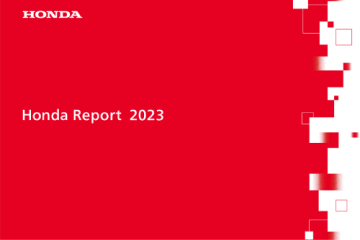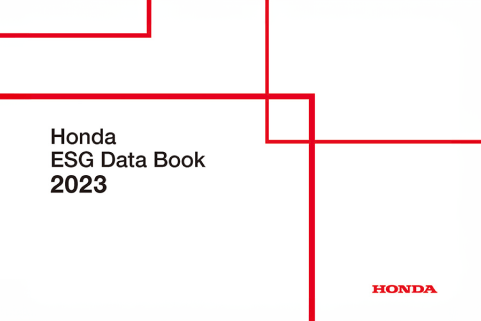Response to TCFD Recommendations

In treating responses to climate change and energy-related issues as crucial in the environmental field, in April 2021, Honda announced, its vision to “realize carbon neutrality for all products and corporate activities Honda is involved in by 2050.”
Hence, we have declared our support to the Task Force on Climaterelated Financial Disclosures (TCFD), established by the Financial Stability Board (FSB), as well as disclosing information based on the information disclosure framework recommended by the TCFD.
The recommended disclosures for the core elements of the framework - Governance, Strategy, Risk Management and Metrics and Targets - are listed at the end of the relevant text. We will continue to promote the disclosure of information related to climate change, while conducting scenario analysis on climate change risks and opportunities and reflecting the results in our management strategies.
Governance
Honda is promoting Group-wide efforts to realize a society with zero environmental impact throughout its life cycle. Honda’s long-term management policies and medium-term management plan are approved and resolved by the Executive Council (chaired by the Director, President, and Representative Executive Officer, and Chief Executive Officer) and the Board of Directors. The Board of Directors is the final supervisory body, covering actions to address climate change issues. The Executive Council deliberates in advance on matters to be resolved by the Board of Directors and discusses important management matters within the scope of authority delegated to it by the Board of Directors.
In response to the need to address various risks associated with business activities and to oversee business operations for the sustainable development of society and Honda, Honda has designated knowledge in ESG and Sustainability, including ability in addressing climate change issues, as one of the necessary skills and appointed directors accordingly.
Each Operation and Supervisory Unit and subsidiary formulates and promotes action plans and measures based on the company-wide long-term management policies and medium-term management plan, and important matters are reported and approved at the Executive Council as appropriate. Respective Business Operations and Regional Operations formulate action plans and promote measures based on the global medium- to long-term environmental policies, based on information shared at the Global Environmental Secretariat Meeting (Secretariat: Corporate Strategy Operations).
Each of Regional Operations holds a Regional Environmental Meeting to promote the PDCA (Plan-Do-Check-Act) cycle within Regional Operations. Each of Business Operations monitors regional progress and promotes the PDCA cycle within Business Operations. The Corporate Strategy Operations monitors the progress at Business Operations and Regional Operations and considers revisions to the medium- to long-term environmental policies and targets as necessary. Important matters are reported and approved at the Executive Council and reported and resolved at the Board of Directors. For important cross-departmental issues such as addressing climate change issues, a cross-departmental task force is formed to consider and propose action plans and measures as appropriate, and important matters are reported and approved at the Executive Council.
Compliance and risk management related to the environment, including climate change, are operated by the Company’s basic policies for the development of internal control systems.
Toward the realization of a society with zero environmental impact, Honda’s Board of Directors and Executive Council regularly monitor the progress of KGIs for which the Board of Directors is responsible for supervision and KPIs for which the Executive Council is responsible for execution, thereby reinforcing management governance. Please refer to Item 6 B. “Compensation” in the Form-20F for details of the executive remuneration system linked to financial and non-financial indicators.
FORM 20-F | IR Library | Investor Relations | Honda Motor Co., Ltd. (global.honda)
Environmental Management Structure

Strategy
To achieve more sustainable corporate management, Honda identifies climate change-related risks and opportunities, reflects them in the corporate strategy, and promotes initiatives to generate new business opportunities through advancing Honda’s technologies, products and services. Honda will continue its efforts to enhance the corporate resilience.
Scenario Analysis Overview
To evaluate and examine the impacts of climate change on our business, Honda has defined multiple scenarios and conducted the scenario analysis noted in the TCFD recommendations. In the scenario analysis, Honda has set multiple scenarios including a scenario with significant policy transition which is based on the target laid out in the Paris Agreement “to limit the temperature increase to 1.5℃ above pre-industrial levels” (1.5℃ scenario) and a scenario where environmental regulations are not strengthened, leading to physical risks increase (4℃ scenario). In the scenario analysis, Honda has examined climate-related risks and opportunities for motorcycle, automobile, and power products businesses in accordance with the classification of the TCFD recommendations and quantified the financial impact by the year 2030 under the scenario to the extent possible for evaluation and analysis.
For the scenario analysis based on the TCFD recommendations, we primarily used the following scenarios.
1.5℃ scenario
Honda refers to the Net Zero Emissions Scenario (NZE) of the IEA (International Energy Agency) and the IPCC (Intergovernmental Panel on Climate Change) AR6 SSP1-1.9. As part of the 1.5℃ scenario, Honda assumes that measures to achieve carbon neutrality by 2050 will be promoted across the world, and that the development and use of new technologies will promote the widespread use of carbon-free products and renewable energy. Additionally, the transition to a circular economy is assumed to accelerate. In the automobile industry, we assume even more stringent regulations on fuel efficiency and zero-emission vehicles (ZEVs), and, as a result, producing a rise in demand for electric vehicles (EVs) and fuel cell electric vehicles (FCEVs) — although mainly in developed countries. Furthermore, in the motorcycle, automobile, and power products businesses, we assume that customers’ sense of value will shift, with an increasing number developing a preference for carbon-free products and services.
4℃ Scenario
Honda has developed our 4℃ scenario by using IPCC AR6 SSP3-7.0. In the 4℃ scenario, we assume that irreversible environmental changes will occur, leading to more frequent and more severe natural disasters.
Risks and Opportunities and Honda’s Responses
| Risk | Opportunity | Response | |||
|---|---|---|---|---|---|
| Transition Risk |
1.5℃ | Policy and Regulation |
|
|
|
| Changes in Market |
|
||||
| Physical Risk |
4℃ | Acute/ Chronic |
|
|
|
This list is not intended to be exhaustive and does not cover all risks and opportunities or Honda’s measures with respect thereto.
Risk Management
Honda has established the Risk Management Committee to identify, check and discuss the status of company-wide priority risks which are deemed particularly important for the entire corporate entity. “Climate change-related risks” such as risks related to environmental regulations and natural disasters caused by climate change are also managed and monitored by the Committee, which leads to promoting more effective risk management activities while considering the characteristics of respective Operations. The Corporate Strategy Operations evaluates and identifies climate change-related risks by conducting scenario analysis in line with TCFD recommendations, reflecting external and internal risk information which includes company-wide priority risks. The results of the scenario analysis of climate change-related risks are shared with the Risk Management Committee. Climate change-related risks are mainly addressed by the Corporate Strategy Operations, Business Operations and Regional Operations as well as by each respective Operation, Supervisory Unit, subsidiary and cross-departmental task force. Important matters related to risk management including the responses to the climate change-related risks are discussed by the Committee, and details of their activities are reported to the Executive Council as appropriate. For more explanation of the risk assessment and management process, please refer to “Honda ESG Data Book”.
Honda ESG Data Book 2024 p.140(PDF:13.7MB)
Metrics and Targets
By 2050, Honda is seeking to realize carbon neutrality for all products and corporate activities the Company is involved with.
| Target for 2030 | Target for 2050 | ||
|---|---|---|---|
|
Reduction rate of total CO₂ emissions from corporate activities (compared to FY2020) |
46% | Net zero CO₂ emissions | |
| Sales ratio of electrified products | Motorcycles | 15% | |
| Automobiles | 30% | ||
| Power products | 36% | ||
|
Reduction rate of CO₂ emissions intensity of product use (compared to FY2020) |
Motorcycles | 34.0% | |
| Automobiles | 27.2% | ||
| Power products | 28.2% | ||
Honda's GHG Emissions
Honda believes that calculating and disclosing its greenhouse gas (GHG) emissions as a responsible mobility company is a necessary step for proactively promoting GHG emissions reduction efforts across the world.
Given our business characteristics, our value chain produces large emissions, including those from product use. As such, it is important to calculate and disclose Scope 3 emissions. Consequently, we calculate and disclose emissions from our value chain (Scope 3), in addition to direct (Scope 1) and indirect (Scope 2) Honda emissions.
We will continue to identify and manage related data, which will be utilized to implement GHG emissions reduction measures.
| (million t-CO2e) | FY2020 | FY2021 | FY2022 | FY2023 | FY2024 |
|---|---|---|---|---|---|
| Emissions from the entire value chain | 331.2 | 254.48 | 280.02 | 288.23 | 270.49 |
| Scope 1 | 1.24 | 1.12 | 1.16 | 1.09 | 1.07 |
| Scope 2 | 3.79 | 3.38 | 3.14 | 2.73 | 2.07 |
| Scope 3 | 298.09 | 249.98 | 275.72* | 284.41 | 267.35 |
- The definitions of Scopes 1, 2 and 3 are provided in the GHG Protocol.
-
Scopes 1&2: Direct and indirect GHG emissions from the corporate activities of Honda Motor Co., Ltd. and its consolidated subsidiaries and affiliated companies in and outside of Japan, excluding some small companies. See Honda ESG Data Book 2024 p.149 for details.
Honda ESG Data Book 2024 p.149 (PDF: 12.6MB) - The Scope 3 figures are the sum of emissions from categories 1, 2, 3, 4, 5, 6, 7, 9, 10, 11, 12 and 15.
We changed the calculation method of Scope 3 Category 11 emissions from FY2022. See Honda ESG Data Book 2024 p.148 for details.
Honda ESG Data Book 2024 p.148 (PDF: 12.6MB)




